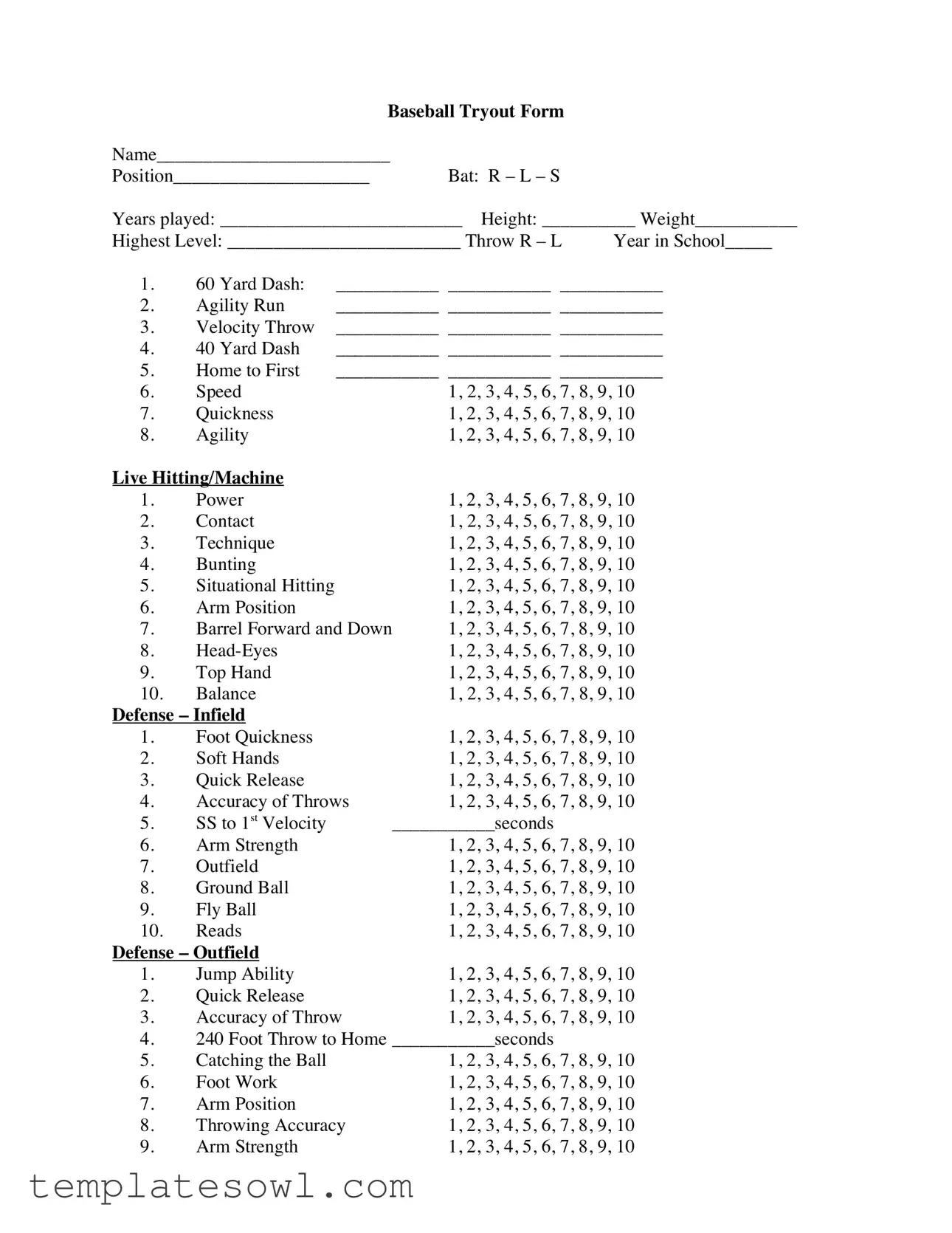Pitching |
|
|
|
|
1. |
Form/Mechanics |
1, 2, 3, 4, 5, 6, 7, 8, 9, |
10 |
2. |
Control |
1, 2, 3, 4, 5, 6, 7, 8, 9, |
10 |
3. |
Velocity |
1, 2, 3, 4, 5, 6, 7, 8, 9, |
10 |
4. |
Breaking Pitch |
1, 2, 3, 4, 5, 6, 7, 8, 9, |
10 |
5. |
Change Up |
1, 2, 3, 4, 5, 6, 7, 8, 9, |
10 |
6. |
Fastball |
1, 2, 3, 4, 5, 6, 7, 8, 9, |
10 |
7. |
Throws Down Hill |
1, 2, 3, 4, 5, 6, 7, 8, 9, |
10 |
8. |
Command |
1, 2, 3, 4, 5, 6, 7, 8, 9, |
10 |
Catching |
|
|
|
|
1. |
Blocking |
1, 2, 3, 4, 5, 6, 7, 8, 9, |
10 |
2. |
Time Throws to 2nd |
___________ |
___________ |
___________ |
3. |
Feet |
1, 2, 3, |
4, 5, 6, 7, 8, 9, |
10 |
4. |
Receiving |
1, 2, 3, 4, 5, 6, 7, 8, 9, |
10 |
Sliding |
|
|
|
|
1. |
Figure 4 |
1, 2, 3, 4, 5, 6, 7, 8, 9, |
10 |
2. |
Hook |
1, 2, 3, 4, 5, 6, 7, 8, 9, |
10 |
3. |
Head First |
1, 2, 3, 4, 5, 6, 7, 8, 9, |
10 |
4. |
Sliders Aggressive |
1, 2, 3, 4, 5, 6, 7, 8, 9, |
10 |
5. |
Coordinated Fluid |
1, 2, 3, 4, 5, 6, 7, 8, 9, |
10 |
6. |
Aggressive |
1, 2, 3, 4, 5, 6, 7, 8, 9, |
10 |
Intensity Rating |
|
|
|
1. |
Evaluation |
1, 2, 3, 4, 5, 6, 7, 8, 9, |
10 |
2. |
Arm Strength |
1, 2, 3, 4, 5, 6, 7, 8, 9, |
10 |
3. |
Conditioning |
1, 2, 3, 4, 5, 6, 7, 8, 9, |
10 |
4. |
Athleticism |
1, 2, 3, 4, 5, 6, 7, 8, 9, |
10 |
Base Running |
|
|
|
1. |
Jumps/Reads |
1, 2, 3, 4, 5, 6, 7, 8, 9, |
10 |
2. |
Advance Property |
1, 2, 3, 4, 5, 6, 7, 8, 9, |
10 |
3. |
Reads Picks |
1, 2, 3, 4, 5, 6, 7, 8, 9, |
10 |
4. |
Reads Foot |
1, 2, 3, 4, 5, 6, 7, 8, 9, |
10 |
5. |
Primary/Property |
1, 2, 3, 4, 5, 6, 7, 8, 9, |
10 |
6. |
Secondary |
1, 2, 3, 4, 5, 6, 7, 8, 9, |
10 |
7. |
Set Up/Feet |
1, 2, 3, 4, 5, 6, 7, 8, 9, |
10 |
Hustle/Work Habits |
1, 2, 3, 4, 5, 6, 7, 8, 9, |
10 |
Commitment |
1, 2, 3, 4, 5, 6, 7, 8, 9, |
10 |
Attitude |
|
1, 2, 3, 4, 5, 6, 7, 8, 9, |
10 |
Baseball Knowledge |
1, 2, 3, 4, 5, 6, 7, 8, 9, |
10 |
Best Potential Position |
___________________ |
